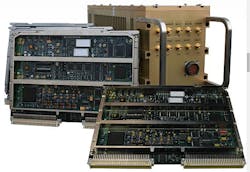Navy taps Mercury for advanced research in DRFM-based airborne electronic warfare (EW)
LAKEHURST, N.J. –Electronic warfare (EW) experts at Mercury Systems will continue work on DRFM-based airborne electronic attack technology for the U.S. Navy that can confused enemy radar by projecting several different false radar images.
Officials of the U.S. Naval Air Warfare Center Aircraft Division in Lakehurst, N.J., announced an $8.4 million order Wednesday to the Mercury Defense Systems subsidiary in Cypress, Calif., for small business innovation research (SBIR) phase III work to complete an effort in advanced techniques for digital radio frequency memories (DRFM).
This project is related to DRFM electronic jammers, which provide coherent time delay of RF signals in applications like radar and electronic warfare. It also produces coherent deception radar jamming by replaying a captured radar pulse with a small delay, which makes the target appear to move.
DRFM also can modulate captured pulse data in amplitude, frequency, and phase to provide other affects. A Doppler shift correlates range and range rate trackers in the radar. DRFM also can replay captured radar pulses many times to fool the radar into perceiving many targets.
Mercury has developed the modular digital receiver exciter (MoDREx) to complement systems employing full EW suites under a previous Navy SBIR contract. MoDREx is a flight-qualified suite of subassemblies with capabilities researched and demonstrated under Navy SBIR N06-036 Advanced Techniques for DRFMs.
Related: Navy and Air Force choose DRFM jammers from Mercury Systems to help spoof enemy radar
The system helps generate electronic attack (EA) techniques, ranging from individual emitters to several independently operated emitters. MoDREx emitter filtering separates several emitter signals, while its adaptive technique generation responds to emitter changes.
Mercury engineers derived MoDREx from the company's domain expertise in flight test and training DRFM subsystems and tactical DRFM solutions. It supports emerging EW applications that do not have or cannot afford a full EW radar warning receiver, Mercury officials say. The modular architecture of MoDREx enables systems integrators to tailor system capabilities to the application or mission.
MoDREx technology features integrated wideband digital; Receiver and Controller; one to six RF converter modules; one to twelve micro-DRFM modules; integrated wideband digital receiver/controller; emitter characterization and identification; a library of electronic attack techniques matched to input signal characteristics; ability to track as many as 12 simultaneous time coincident emitters; multi-threat signal sorting and routing to assigned RF converter and micro-DRFMs.
This technology also offers characterization and logging support; post analysis/verification/validation; tunable RF converter modules, each assigned to a tracked emitter; converts emitter band to micro-DRFM instantaneous bandwidth (IBW); Expandability to varying performance and bandwidth; modules that integrate a DRFM, techniques generator, and tracker; eight bits amplitude encoding at 1 GHz IBW; internal techniques against several emitters; several simultaneous electronic attack response and emitter signals; as many as eight independent electronic attack response/targets/modules; and programmable electronic attack response to targets for range, Doppler, amplitude, phase, noise, and arbitrary waveform generation.
Related: Data converter XMC embedded computing module for DRFM applications introduced by Pentek
Small packages, fast response, and large volumes of low-latency compute power define modern DRFM evolution, Mercury officials say. The company can produce DRFM modules as thin as 0.44 inches that capitalize on direct digital synthesizer (DDS) local oscillator (LO) technology.
DDS delivers sub-microsecond tuning speeds over a wide bandwidth, while advanced circuit design and simulation helps reduce spurious, inter-module and phase noise.
Mercury Defense Systems, formerly KOR Electronics, has developed the Mercury Airborne 1225 advanced DRFM electronic warfare (EW) jammers to support Navy and Air Force aircraft.
Related: Air Force eyes digital radio technologies for spectrum warfare and jam-resistant AESA radar
Mercury engineers developed the Mercury Airborne 1225 ruggedized air-cooled, airborne 3-bit miniaturized digital RF memory (DRFM) for airborne, pod, and unmanned aerial vehicle applications with as much bandwidth as 1200 MHz. It is self-contained with internal techniques and RF and power supplies.
On this week's order Mercury will do the work in Cypress, Calif., and West Caldwell, N.J., and should be finished by January 2021. For more information contact Mercury Defense Systems online at www.mrcy.com, or the Naval Air Warfare Center Aircraft Division-Lakehurst at www.navair.navy.mil.
Ready to make a purchase? Search the Military & Aerospace Electronics Buyer's Guide for companies, new products, press releases, and videos

John Keller | Editor
John Keller is editor-in-chief of Military & Aerospace Electronics magazine, which provides extensive coverage and analysis of enabling electronic and optoelectronic technologies in military, space, and commercial aviation applications. A member of the Military & Aerospace Electronics staff since the magazine's founding in 1989, Mr. Keller took over as chief editor in 1995.

